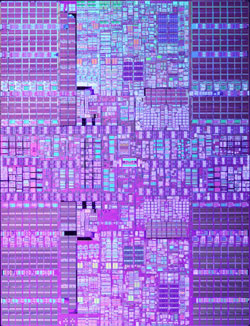IBM launches “green” chip
IBM launches “green” chip
mongabay.com
May 22, 2007
IBM is touting the “green” credentials of its newest and most powerful microprocessor, the “Power6.”
The tech firm says that the chip has a record speed of 4.7, offering double the speed of previous generation ‘Power5’ processors, but uses roughly the same power consumption, effectively halving performance per unit of energy.
IBM joins a pack of other tech companies — including Hewlett Packard, Sun Microsystems, and AMD — emphasizing the energy efficiency of their products. The trend comes as a study by research firm IDC finds that enterprise consumers are increasingly concerned about the rising cost of power. Nationwide, centers consume 45 billion kilowatts of energy per year resulting in total utility bills amounting to $2.7 billion, reports Jonathan Koomey, a staff scientist at Lawrence Berkeley National Laboratories. Globally, data centers used $7.2 billion in electricity in 2005.

IBM’s new POWER6 chip is a 64 bit, dual-core processor with 790 million transistors running at up to 4.7 GHz and eight megabytes of on chip Level 2 cache. The company today launched its first new POWER6 server, the IBM System p 570, which has set 25 performance benchmark records across a broad range of business and technical applications. |
Last week IBM announced it will spend $1 billion per year to increase energy efficiency in information technology under a program called “Project Big Green.” The plan includes new products and services to reduce corporate data center energy consumption.
IBM says that the POWER6 chip has additional techniques to conserve power and reduce heat, including processor clocks that can be dynamically turned off when there is no useful work to be done and turned back on when there are instructions to be executed.
Related articles
Apple defends green credentials, promises to do better.
(5/4/2007) In a open letter posted Wednesday, Apple Inc. CEO Steve Jobs countered claims by green groups that the iPod and computer maker lagged in recycling and removing toxic chemicals from its products. He said the company is already an industry leader when it comes to the environment and that Apple will continue to reduce its impact on the planet.
Data centers use at least $7.2 billion in electricity globally.
(2/15/2007) U.S. data centers consume 45 billion kilowatts of energy per year, according to a new study, commissioned by computer chip maker AMD. Jonathan Koomey, a staff scientist at Lawrence Berkeley National Laboratories and a consulting professor at Stanford University, calculated that in 2005 total data center electricity consumption in the U.S., including servers, cooling and auxiliary equipment, was approximately 45 billion kWh, resulting in total utility bills amounting to $2.7 billion. Globally, data centers used $7.2 billion in electricity.
Green computing – Dell releases energy-saving server.
(12/4/2006) Dell released a premium line of energy-efficient servers that consume considerably less power than regular models, joining a list of firms that offer consumers 'greener' products.
NAND PCs may have environmental benefits over standard hard disk PCs.
(10/13/2006) Fujitsu announced it will start shipping PCs that use NAND-flash drives instead of standard hard drives. While the new format will be substantially more expensive — on the order of $670 to replace a 20GB hard drive with a 16GB worth of flash memory — it will make the laptops lighter and more shock-resistant, extend battery life by 30 minutes and improve system performance on start-up. The shift may have ancillary benefits as well: less energy usage and reduction of components that use metals. The following originally appeared on October 28, 2006 on mongabay.com.
https://news.mongabay.com/2006/1114-google_earth-act.html>Amazon Indians use Google Earth, GPS to protect forest home.
(11/14/2006) Deep in the most remote jungles of South America, Amazon Indians are using Google Earth, Global Positioning System (GPS) mapping, and other technologies to protect their fast-dwindling home. Tribes in Suriname, Brazil, and Colombia are combining their traditional knowledge of the rainforest with Western technology to conserve forests and maintain ties to their history and cultural traditions, which include profound knowledge of the forest ecosystem and medicinal plants. Helping them is the Amazon Conservation Team (ACT), a nonprofit organization working with indigenous people to conserve biodiversity, health, and culture in South American rainforests.